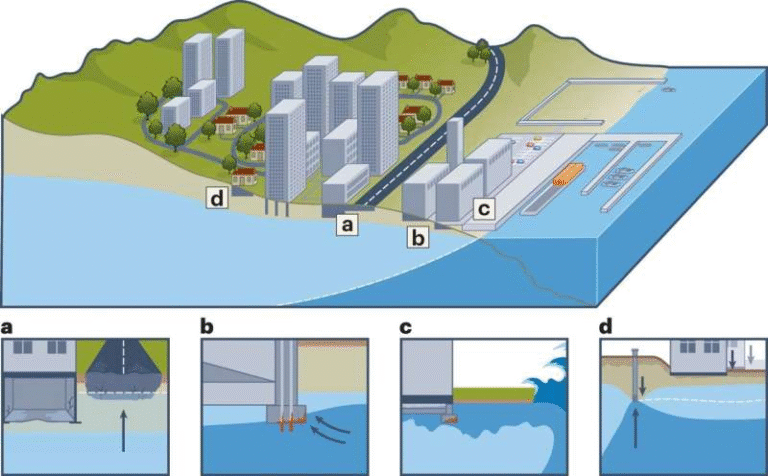Seismic Anisotropy Reveals Mysterious Viscous “BLOBs” Deep Inside Earth’s Mantle

Scientists have taken a major step toward understanding what’s happening in the deepest layers of our planet, right above the Earth’s core. A new study published in Geochemistry, Geophysics, Geosystems (2025) reveals how seismic anisotropy—the way seismic waves travel at different speeds depending on direction—can help uncover the behavior of giant dense structures at the base of Earth’s mantle. These continent-sized regions, often called BLOBs (short for big lower-mantle basal structures) or LLSVPs (Large Low-Shear-Velocity Provinces), are crucial for understanding how Earth’s interior moves and evolves.
This new research, led by Poulami Roy and her team, combines advanced computer modeling with seismic observations to figure out how these mysterious deep-Earth features deform, flow, and interact with mantle plumes and subducting tectonic plates. Their simulations offer one of the clearest pictures yet of the dynamic world 2,900 kilometers beneath our feet.
Understanding Seismic Anisotropy
In simple terms, seismic anisotropy means that seismic waves don’t move uniformly through Earth’s interior. Instead, depending on the direction they travel, they move faster or slower. This variation reveals how rocks deep underground are stretched, compressed, or aligned over millions of years.
Anisotropy is particularly important in studying the D″ layer, the bottom 300 kilometers of the mantle sitting just above the liquid outer core. Here, the intense heat and pressure cause rock to deform and align in specific patterns. In contrast, regions that are isotropic let seismic waves pass through equally in all directions, showing little deformation.
The D″ layer is also where mantle plumes—columns of hot rock rising from deep within the Earth—form. These plumes eventually feed volcanic hotspots on the surface, such as those beneath Hawaii or Iceland. Studying anisotropy in this zone allows scientists to connect surface volcanism with deep-Earth flow patterns.
The Giant BLOBs Beneath the Mantle
At the very base of the mantle, scientists have long identified massive structures known as LLSVPs. There are two major ones: one under the Pacific Ocean and one beneath Africa. These enormous “blobs” are thought to be hotter, denser, and chemically distinct from the surrounding mantle.
They’re sometimes called thermochemical piles because they have both thermal (temperature-related) and chemical differences compared to the rest of the mantle. What has puzzled geophysicists for decades is why these structures exist, how stable they are, and how they affect mantle convection—the slow churning motion that drives plate tectonics.
The new study digs into exactly that: by modeling the viscosity (resistance to flow) and density of these blobs, the researchers aimed to explain the observed seismic anisotropy at their boundaries.
Modeling Earth’s Deep Interior
To tackle this problem, the research team used two advanced computer programs: ASPECT and ECOMAN.
- ASPECT is a powerful 3D mantle convection simulation tool that models how the mantle moves and circulates over geological timescales.
- ECOMAN simulates mantle fabric development, showing how minerals deform and align to produce the anisotropy detected by seismic waves.
Together, these tools allowed the scientists to run global simulations of Earth’s mantle over the past 250 million years—covering key geological events such as the breakup of Pangaea, the opening of the Atlantic Ocean, and the evolution of subduction zones where tectonic plates sink into the mantle.
They tested five different mantle model configurations, varying how dense and viscous the BLOBs were compared to the rest of the mantle. The goal was to find the version that best reproduced the patterns of anisotropy seen in seismic observations.
What They Found
The results were revealing. The team discovered that the best match to real-world data occurred when the BLOBs were about 2% denser and 100 times more viscous than the surrounding mantle.
This means these structures are much thicker and more resistant to flow, which helps explain their stability over hundreds of millions of years. Despite the constant movement of tectonic plates and mantle convection, these blobs stay largely intact.
Interestingly, the models showed that most of the deep mantle remains isotropic—relatively undisturbed by large-scale flow. But strong anisotropy appears around the edges of the BLOBs, where mantle plumes rise and subducted slabs sink. These boundary zones are areas of intense deformation, and that’s where the seismic anisotropy is strongest.
In other words, the edges of these deep structures are geodynamically active, while their interiors remain relatively calm. The plumes that feed volcanic hotspots tend to originate from these boundary zones, suggesting a deep connection between the BLOBs and surface volcanism.
Why This Matters
Understanding these deep-Earth structures isn’t just about satisfying curiosity. The LLSVPs may play a central role in controlling how heat and material move through the planet.
They influence:
- Where mantle plumes form (and thus where volcanic hotspots appear).
- How subducting tectonic slabs behave when they reach the core-mantle boundary.
- The long-term evolution of Earth’s magnetic field and thermal history.
If these BLOBs are indeed highly viscous and chemically distinct, they might also be very ancient, possibly containing remnants of the early Earth’s crust or material from the planet’s formation. Some scientists even speculate that these piles could hold traces of thea-sized planetary debris from early solar system collisions.
The study also strengthens the case that seismic anisotropy can serve as a window into the planet’s deepest dynamics. By analyzing how seismic waves behave, researchers can infer the flow, deformation, and stability of the lowermost mantle—something we can never observe directly.
The Big Picture: Earth’s Mantle in Motion
To put this in perspective, the mantle makes up about 84% of Earth’s volume and extends roughly from 35 to 2,900 kilometers below the surface. It behaves like a solid that flows slowly over time, driving the movement of tectonic plates.
In this massive convective system, subduction zones act as conveyor belts pulling cold slabs downward, while mantle plumes bring heat upward from the core-mantle boundary. The interaction of these flows helps shape continents, create mountains, and fuel volcanic activity.
At the bottom of all this motion sit the LLSVPs—immense, sluggish regions that anchor deep convection patterns. By resisting flow, they act as stabilizing anchors in the mantle’s chaotic churn. Their edges, however, are hotbeds of activity, generating plumes and anisotropy that connect deep Earth to the surface we live on.
Limitations and Future Research
Even though this study offers one of the most detailed models yet, there are still open questions.
- The exact composition of the BLOBs remains uncertain—are they mostly thermal, or also chemically unique?
- How do ultra-low velocity zones (ULVZs), small patches near the core-mantle boundary, fit into this picture?
- And could phase changes or partial melting in minerals contribute to anisotropy as well?
Future models that include finer-scale structures, realistic mineral physics, and higher seismic resolution could help answer these questions. Meanwhile, improved global seismic networks will continue refining our map of anisotropy in the D″ layer.
A Window into Earth’s Hidden Heart
This research is a reminder that the deep Earth remains one of the last unexplored frontiers of our planet. We can’t drill to these depths or see them directly, but by interpreting the way seismic waves move through rock, scientists are piecing together a story of incredible complexity.
The discovery that BLOBs are both dense and incredibly viscous—and that anisotropy is concentrated at their edges—adds a crucial piece to the puzzle of how our planet breathes, moves, and evolves from its fiery core to its shifting surface.





